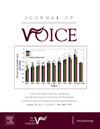Mapping of the Execution of Resonance Tubes Phonation Immersed in Water Exercise in Adults: A Scoping Review
IF 2.5
4区 医学
Q1 AUDIOLOGY & SPEECH-LANGUAGE PATHOLOGY
引用次数: 0
Abstract
Objective
To map the execution of resonance tubes phonation immersed in water exercise in adults with healthy or altered voices.
Methods
This study was a scoping review. An electronic search was performed using the following databases: MEDLINE, LILACS, SCOPUS, Web of Science, EMBASE, Cochrane Library, gray literature, and a manual search. A blinded review was performed by two authors to determine the selection and extraction procedures. Studies with adult participants with dysphonic or healthy voices who underwent intervention with phonation in a resonance tube immersed in water in the context of the vocal clinic, with an experimental intervention, quasi-experimental, or before and after the intervention were included. Data from the publication, sample, execution, and results obtained from the exercises were extracted by two blinded reviewers. Disagreements were resolved through consensus. The analysis was performed quantitatively.
Results
A total of 44 publications were analyzed. Among these, Brazilian studies were the most frequent, with a publication peak in 2020. The characterization of the sample was variable, with a higher frequency of participants of both sexes who were not voice professionals. The most frequent studies were before and after exercise with a resonance tube immersed in water, in one session, with an exercise execution time of 3 minutes; in cases of more than one series of executions, the 30-sseconds rest time was more frequent. The most used resonance tube was a flexible silicone tube, with a wall thickness of 0.1 mm, immersion container in a 500-, 510-, or 600-mL bottle, 2/3 filled with water, and the resonance tube immersed 2 cm from the water surface. The most used phonatory task was flow phonation with rounded lips similar to the articulation of the vowel /u/. Acoustic analysis and vocal self-assessment are the most commonly used outcome measures. The best results were obtained in the self-assessment.
Conclusion
There is significant variability in the information on the execution of resonance tubes phonation immersed in water exercise influenced by vocal diagnosis and experience with previous vocal training. Studies on the effects of this exercise have been concentrated over the last decade and are of the vocal training and therapy. Acoustic and self-assessment measures were used to verify the results, with self-assessment being the outcome that most frequently indicated positive results.
绘制成人水中运动共振管发音执行图:范围审查。
目的绘制嗓音健康或嗓音改变的成年人在水中进行共鸣管发音的图谱:本研究为范围综述。使用以下数据库进行了电子检索:MEDLINE、LILACS、SCOPUS、Web of Science、EMBASE、Cochrane Library、灰色文献以及人工检索。由两位作者进行盲审,以确定选择和提取程序。研究对象包括嗓音有障碍或嗓音健康的成年参与者,他们在声乐诊所的背景下在浸入水中的共鸣管中接受了发音干预、实验干预、准实验干预或干预前后的干预。由两名盲审员从出版物、样本、执行情况和练习结果中提取数据。如有分歧,则通过协商一致的方式解决。分析以定量方式进行:共分析了 44 篇出版物。结果:共分析了 44 篇论文,其中巴西的研究最多,2020 年是论文发表的高峰期。样本的特征各不相同,非嗓音专业的男女参与者较多。最常见的研究是将共振管浸入水中,在运动前后各进行一次运动,运动时间为 3 分钟;在进行不止一次运动的情况下,休息 30 秒的情况更为常见。使用最多的共振管是壁厚为 0.1 毫米的柔性硅胶管,浸入容器为 500、510 或 600 毫升的瓶子,装入 2/3 的水,共振管浸入水面 2 厘米处。最常用的发音任务是圆唇流动发音,类似于元音/u/的发音。声学分析和发声自我评估是最常用的结果测量方法。自我评估的结果最好:结论:受声乐诊断和以往声乐训练经验的影响,在水中进行共鸣管发音练习的信息存在很大差异。关于这种练习效果的研究主要集中在过去十年中的声乐训练和治疗方面。研究采用了声学和自我评估方法来验证结果,其中自我评估是最常显示积极效果的结果。
本文章由计算机程序翻译,如有差异,请以英文原文为准。
求助全文
约1分钟内获得全文
求助全文
来源期刊

Journal of Voice
医学-耳鼻喉科学
CiteScore
4.00
自引率
13.60%
发文量
395
审稿时长
59 days
期刊介绍:
The Journal of Voice is widely regarded as the world''s premiere journal for voice medicine and research. This peer-reviewed publication is listed in Index Medicus and is indexed by the Institute for Scientific Information. The journal contains articles written by experts throughout the world on all topics in voice sciences, voice medicine and surgery, and speech-language pathologists'' management of voice-related problems. The journal includes clinical articles, clinical research, and laboratory research. Members of the Foundation receive the journal as a benefit of membership.
 求助内容:
求助内容: 应助结果提醒方式:
应助结果提醒方式:


